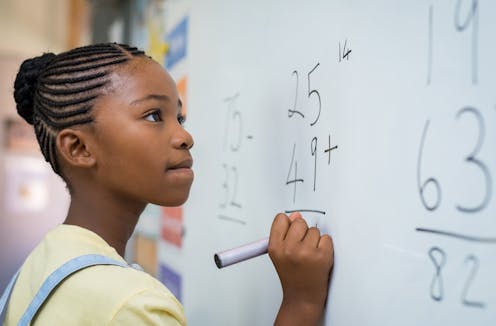 There are so many number systems! The ones you know now were developed over centuries but we are still making up more now. Shutterstock
There are so many number systems! The ones you know now were developed over centuries but we are still making up more now. Shutterstock
If you have a question you’d like an expert to answer, send it to curiouskids@theconversation.edu.au.
How was maths discovered? Who made up the numbers and rules? – Bianca, age 12, Strathfield, Sydney.
We are all born with a brain that understands maths. So are animals, to some extent, but perhaps algebra would be a bit difficult for a giraffe – that is a long stretch.
Throughout history, different cultures have discovered the maths needed for tasks like understanding groups and relationships, sharing food, looking at astronomical and seasonal patterns, and more. There are probably forms of mathematics that were understood by people we don’t even know existed.
Many indigenous cultures worked with different time, measurement, and number ideas suited to their needs and had amazing ways of expressing these ideas. But there are some things that are very common, like counting.
There was an explosion of discovery of mathematics in different cultures at different points in time.
The Greeks didn’t really use algebra the way we do now, but they were amazing with geometry. I am sure you have heard of Pythagoras, but do you know of the woman mathematician Hypatia? She was an amazing teacher and writer skilled at making difficult concepts easy to understand.
Unfortunately, she was killed for her ideas.
Not everyone had the number zero
The Romans were great engineers but they had a terrible number system. It didn’t even have zero.
The number system used in ancient India had zero, but it was known by other very old cultures like the Mayans in Central America and the Babylonians (from ancient Iraq). And ancient Arab mathematicians not only knew about zero but also really spread the idea of algebra after the 9th century (the word comes from a text by a famous mathematician called al-Khwarizmi).
People in the Middle Ages in Europe thought fractions were the hardest maths EVER! One 11th century monk reportedly said:
After spending months working hard and studying, I finally grasped this thing called fractions!
And in the 16th century, people thought negative numbers were pretty evil. They had other names for these numbers, like “absurd” or “defective”.
Read more: Curious Kids: Why do we count to 10?
 Much of our maths is based on one system called base 10, which works on patterns of one to ten (that probably has its roots in the fact that humans have 10 fingers to count on)Shutterstock
Much of our maths is based on one system called base 10, which works on patterns of one to ten (that probably has its roots in the fact that humans have 10 fingers to count on)ShutterstockNumbers and patterns have always been there, waiting to be discovered
There are so many number systems! The ones you know were developed over centuries and we are still making up more now. But much of our maths is based on one system called “base 10”, which works on patterns of one to ten (that probably has its roots in the fact that humans have 10 fingers to count on). It’s also called the decimal system.
But there are lots of other systems, like base 2 (also called the binary system), or base 16 (also called the hexadecimal system).
It sounds complicated but they’re just different ways of organising numbers. Numbers have always been there, waiting to be discovered and so were different ways of organising them.
And over time humans in various cultures have noticed patterns that emerge in numbers, and developed mathematical systems around them.
Breaking the rules
There are plenty of other rules in mathematics, but they are based on recognising patterns and wondering if something works that way all the time. Let’s look at these two equations:
3 x 2 = 6
2 x 3 = 6
You’ve probably learned that it doesn’t matter if you multiply three by two or two by three - you always get six, right? That’s a mathematical “rule” called the “commutative law for multiplication” (“commute” means to move around).
But what if there were some maths worlds where that didn’t happen? Well, there is a certain type of maths, called “matrices”, that was discovered in the 19th century, where you get a different answer, depending on which way you multiply.
Why would anyone want to do that? It turns out that this type of maths is really useful in many different areas, including airline travel and engineering.
You may even end up being a famous mathematician that discovers more maths, creates more rules, or makes up some more names.
About 100 years ago, a mathematician called Edward Kasner was trying to think up a name for a huge number: 1 with one hundred zeros after it. He asked his nine-year-old nephew, Milton Sirotta, who suggested “googol”.
So, Bianca, why not think of a name for a new number? Or look around at some shapes and ask yourself what you might name it?
Read more: Curious Kids: who came up with the first letters?
Hello, curious kids! Have you got a question you’d like an expert to answer? Ask an adult to send your question to curiouskids@theconversation.edu.au
Linda Galligan is a board member the Australian Mathematical Sciences Institute.
Authors: Linda Galligan, Associate professor, University of Southern Queensland
| < Prev | Next > |
|---|







